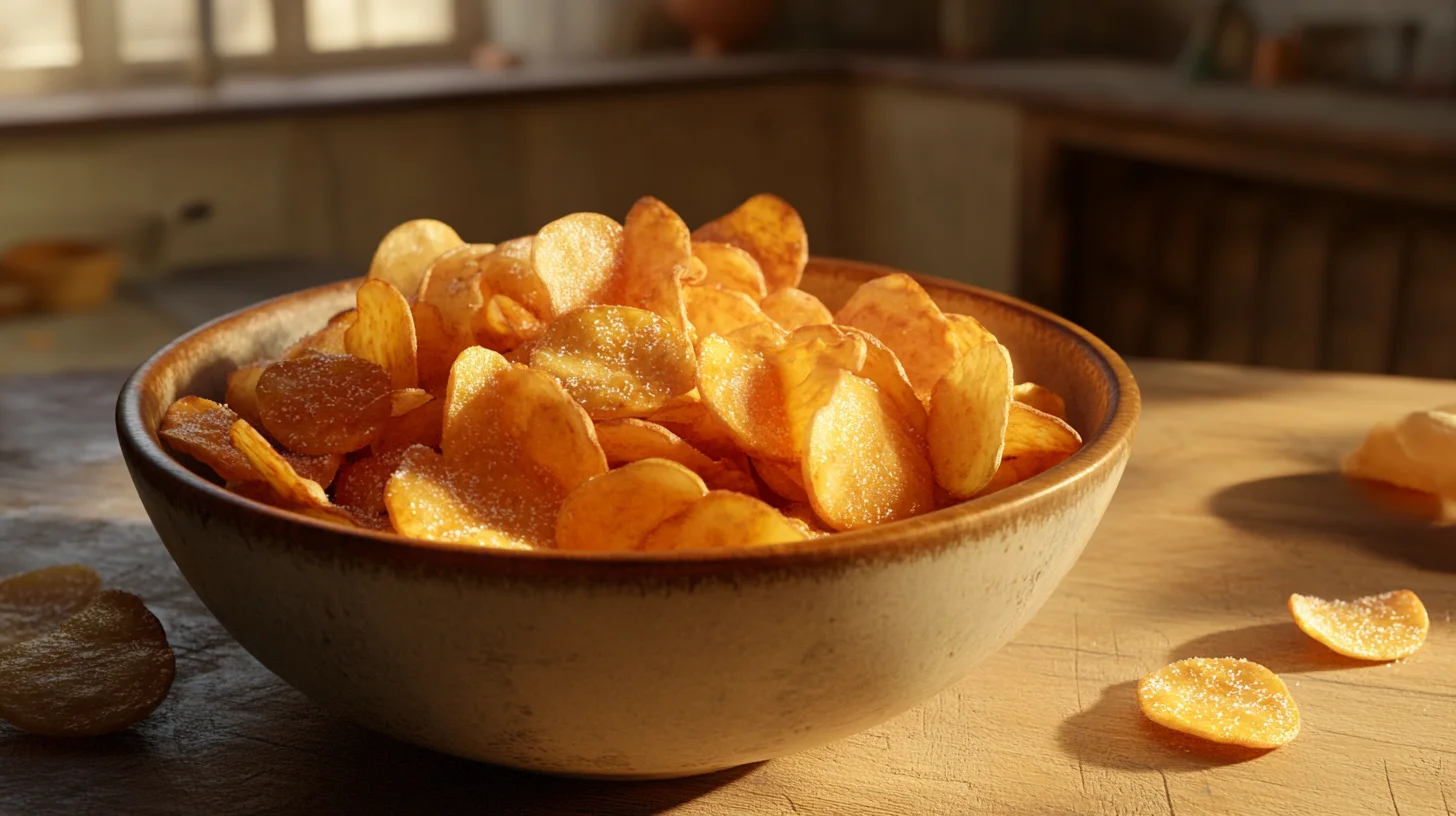When you hear “French Chips,” what comes to mind? A crunchy, golden, and oh-so-delicious snack that’s nearly impossible to resist! French chips, often confused with French fries, are thinly sliced potatoes that are either deep-fried, baked, or air-fried to achieve that perfect crispy texture. Unlike fries, which are usually cut into thick strips, chips are paper-thin and designed for a satisfying crunch with every bite.
Table of Contents
The Difference Between French Chips and French Fries
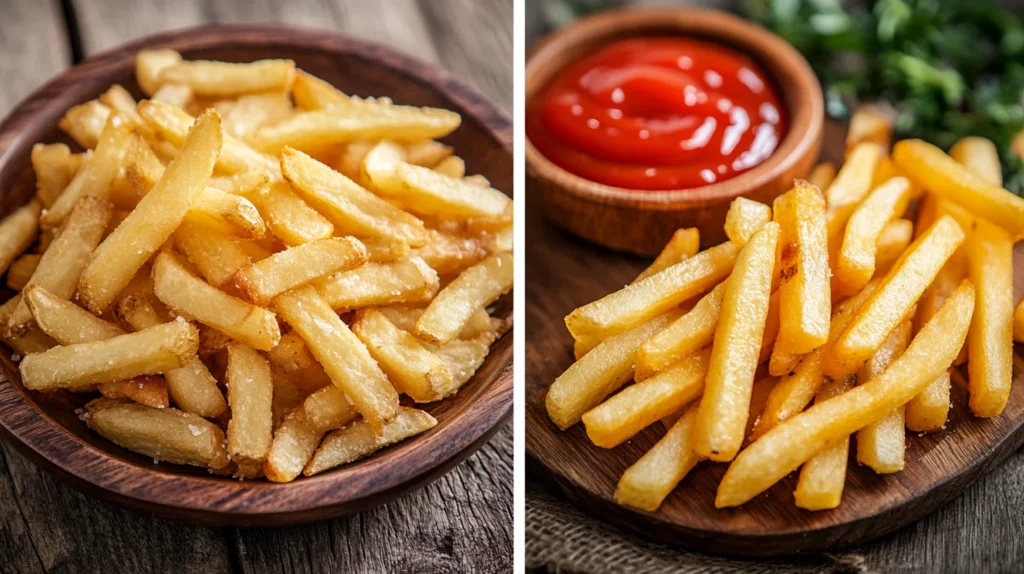
Let’s clear up the confusion! French fries are thick-cut potato sticks, soft on the inside and crispy on the outside. French chips, on the other hand, are ultra-thin, crispy all the way through, and often come in a variety of flavors. Think of it like this: if French fries are the fluffy pillows of the potato world, French chips are the crunchy, addictive crackers.
Why Are French Chips So Popular?
What makes French chips so universally loved? For starters, they’re incredibly versatile. Whether you’re munching on them as a quick snack, pairing them with a gourmet dip, or serving them alongside a juicy burger, they always hit the spot. Plus, their irresistible crunch and wide range of flavors from classic salted to exotic truffle-infused varieties make them a favorite worldwide.
The History and Origin of French Chips
The French Connection: Are They Really French?
Despite the name, French chips don’t have a direct origin in France. Many food historians believe that thinly sliced fried potatoes first became popular in Belgium or even Spain. However, it was the French who perfected the art of frying potatoes, giving birth to both French fries and what we now recognize as French chips.
Evolution of Chips in Global Cuisine
Chips have come a long way! From simple salted versions to gourmet varieties flavored with herbs, spices, and even cheese, this crunchy snack has evolved to satisfy every taste bud. The 20th century saw the mass production of potato chips, making them a global sensation, found in every convenience store, supermarket, and restaurant menu.
How French Chips Are Made: A Step-by-Step Process
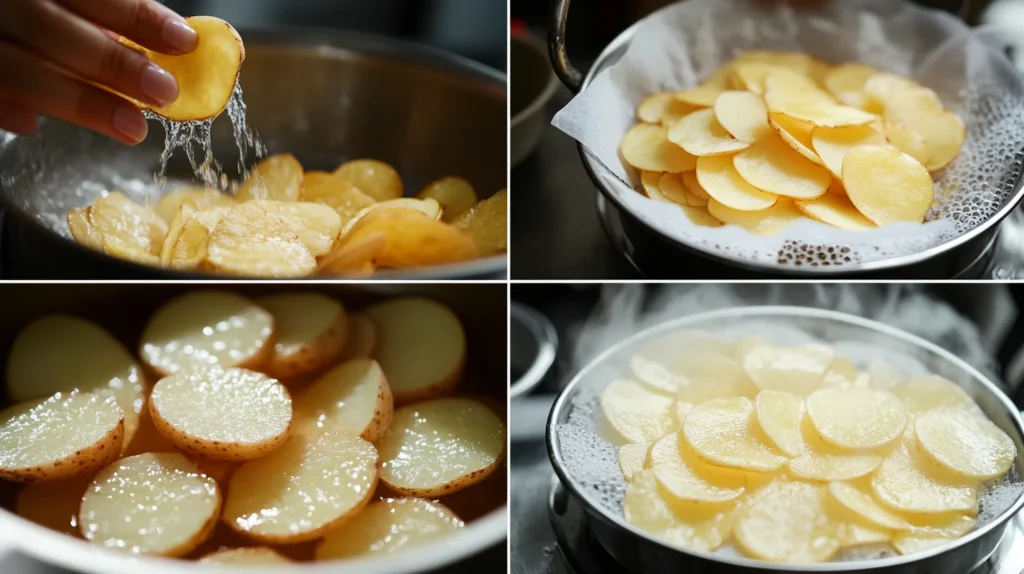
Selecting the Right Potatoes
Not all potatoes are created equal. For the perfect French chips, you’ll need starchy potatoes like Russet or Yukon Gold. These varieties have less moisture, which means crispier chips.
Slicing Techniques: Thick vs. Thin Chips
The thinner, the better! Using a mandoline slicer ensures uniform slices, which fry evenly. If you cut them too thick, they may end up chewy instead of crispy.
The Art of Seasoning French Chips
Seasoning is everything. Some people prefer the classic salt, but why stop there? Paprika, garlic powder, truffle oil, or even a sprinkle of parmesan cheese can elevate your chips to gourmet levels.
Best Cooking Methods: Frying, Baking, and Air Frying
There’s more than one way to get that perfect crunch:
- Deep-frying: The traditional method, giving the best crunch but using a lot of oil.
- Baking: A healthier alternative with less oil but still crispy.
- Air frying: The best of both worlds crunchy, healthier, and quick!
Popular Variations of French Chips Around the World
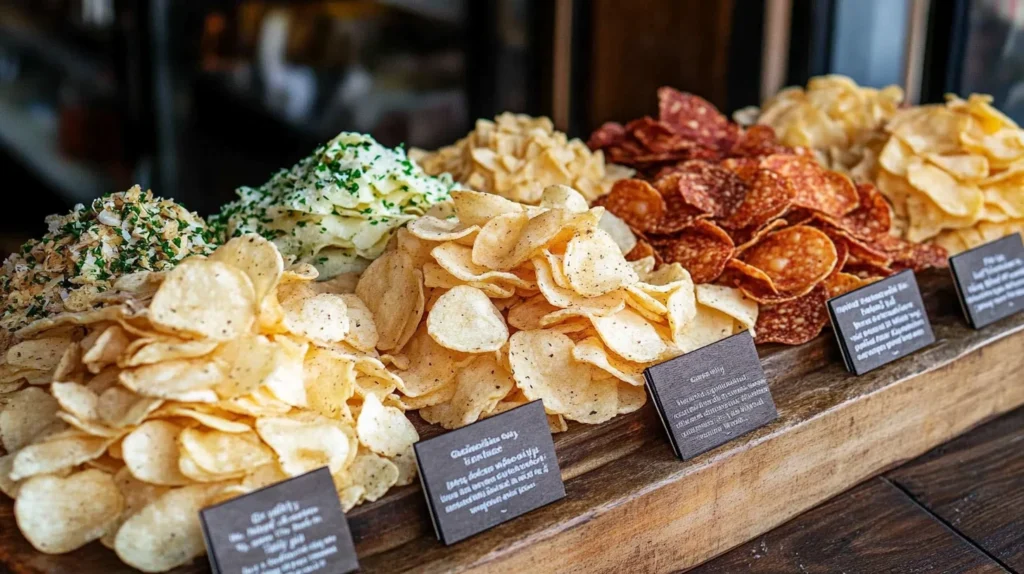
Classic French-Style Chips
The simplest and most beloved form thinly sliced, lightly salted, and perfectly crispy.
Gourmet and Truffle-Infused Chips
For a fancy twist, chefs add truffle oil and parmesan, making these chips a high-end treat.
Spicy, Cheesy, and Other Flavor-Infused Chips
From spicy chili lime to cheesy jalapeño, modern chips come in flavors that cater to every palate.
Healthier Alternatives: Baked and Air-Fried Chips
If you love chips but want to stay healthy, try baking or air frying them with minimal oil.
Common Problems When Making French Chips and Their Solutions
Why Do My Chips Turn Out Soggy?
Solution: Make sure to pat dry the potato slices before frying. Excess moisture leads to soggy chips.
How to Prevent Chips from Sticking Together?
Solution: Spread them out evenly in the fryer or oven, and don’t overcrowd the pan.
Avoiding Excess Oil Absorption
Solution: Fry at the right temperature (around 350°F/175°C) to prevent the chips from soaking up oil.
Maintaining the Right Crispiness and Flavor
Solution: Store chips in an airtight container to keep them crispy for longer.
The Best Dips and Sauces to Pair with French Chips
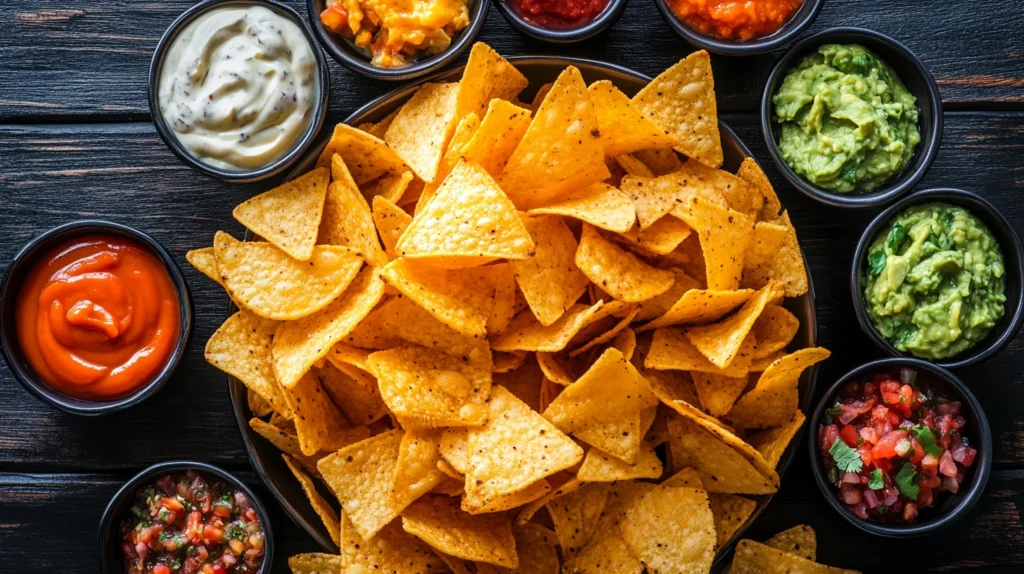
Classic Ketchup and Mayonnaise
You can never go wrong with this timeless combo!
Gourmet Aioli and Truffle Dip
Fancy up your chips with a creamy garlic aioli or truffle-infused dip.
Spicy and Exotic Sauce Pairings
Try salsa, Sriracha, or even guacamole for a bold twist.
French Chips in Restaurants vs. Homemade Chips
Are Restaurant Chips Better?
Some say yes because of high-quality fryers, but homemade chips can be just as good with the right techniques.
Tips for Making Restaurant-Style Chips at Home
- Use high-starch potatoes.
- Slice them thin and evenly.
- Fry in small batches to avoid sogginess.
French Chips: A Crispy Delight Loved Worldwide
Introduction to French Chips
What Are French Chips?
When you hear “French Chips,” what comes to mind? A crunchy, golden, and oh-so-delicious snack that’s nearly impossible to resist! French chips, often confused with French fries, are thinly sliced potatoes that are either deep-fried, baked, or air-fried to achieve that perfect crispy texture. Unlike fries, which are usually cut into thick strips, chips are paper-thin and designed for a satisfying crunch with every bite.
The Difference Between French Chips and French Fries
Let’s clear up the confusion! French fries are thick-cut potato sticks, soft on the inside and crispy on the outside. French chips, on the other hand, are ultra-thin, crispy all the way through, and often come in a variety of flavors. Think of it like this: if French fries are the fluffy pillows of the potato world, French chips are the crunchy, addictive crackers.
Why Are French Chips So Popular?
What makes French chips so universally loved? For starters, they’re incredibly versatile. Whether you’re munching on them as a quick snack, pairing them with a gourmet dip, or serving them alongside a juicy burger, they always hit the spot. Plus, their irresistible crunch and wide range of flavors from classic salted to exotic truffle-infused varieties make them a favorite worldwide.
The History and Origin of French Chips
The French Connection: Are They Really French?
Despite the name, French chips don’t have a direct origin in France. Many food historians believe that thinly sliced fried potatoes first became popular in Belgium or even Spain. However, it was the French who perfected the art of frying potatoes, giving birth to both French fries and what we now recognize as French chips.
Evolution of Chips in Global Cuisine
Chips have come a long way! From simple salted versions to gourmet varieties flavored with herbs, spices, and even cheese, this crunchy snack has evolved to satisfy every taste bud. The 20th century saw the mass production of potato chips, making them a global sensation, found in every convenience store, supermarket, and restaurant menu.
How French Chips Are Made: A Step-by-Step Process
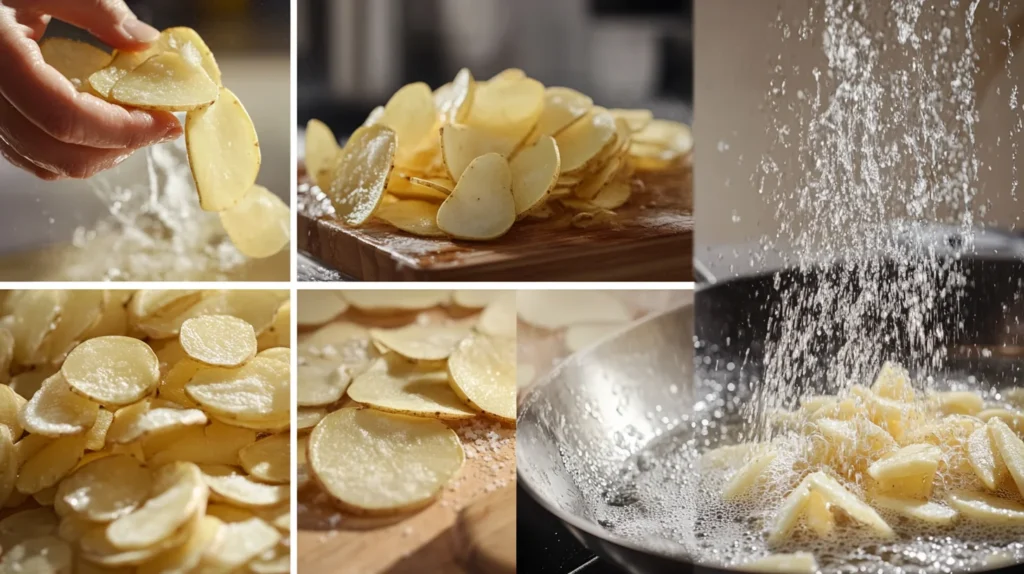
Selecting the Right Potatoes
Not all potatoes are created equal. For the perfect French chips, you’ll need starchy potatoes like Russet or Yukon Gold. These varieties have less moisture, which means crispier chips.
Slicing Techniques: Thick vs. Thin Chips
The thinner, the better! Using a mandoline slicer ensures uniform slices, which fry evenly. If you cut them too thick, they may end up chewy instead of crispy.
The Art of Seasoning French Chips
Seasoning is everything. Some people prefer the classic salt, but why stop there? Paprika, garlic powder, truffle oil, or even a sprinkle of parmesan cheese can elevate your chips to gourmet levels.
Best Cooking Methods: Frying, Baking, and Air Frying
There’s more than one way to get that perfect crunch:
- Deep-frying: The traditional method, giving the best crunch but using a lot of oil.
- Baking: A healthier alternative with less oil but still crispy.
- Air frying: The best of both worlds crunchy, healthier, and quick!
Popular Variations of French Chips Around the World
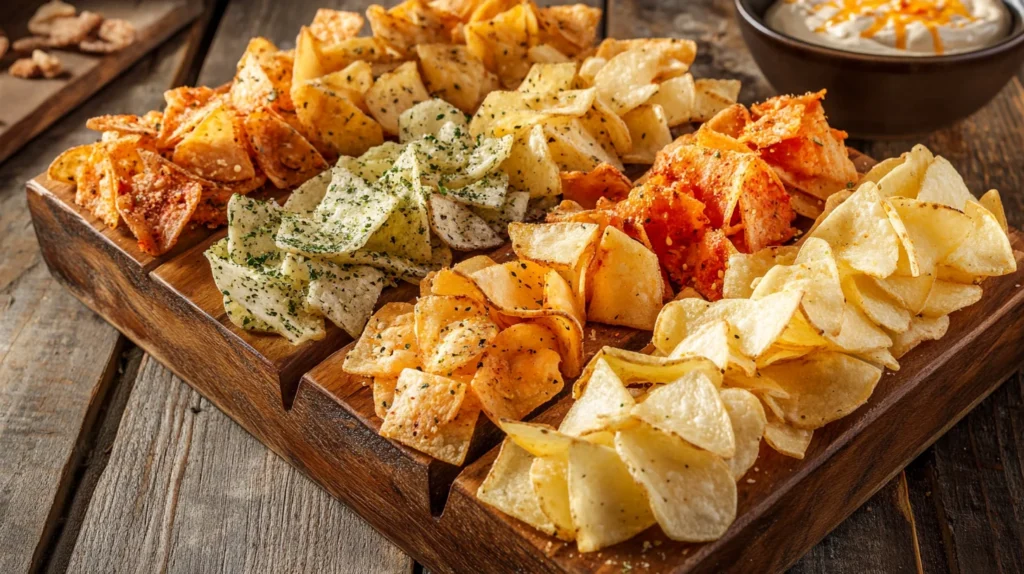
Classic French-Style Chips
The simplest and most beloved form thinly sliced, lightly salted, and perfectly crispy.
Gourmet and Truffle-Infused Chips
For a fancy twist, chefs add truffle oil and parmesan, making these chips a high-end treat.
Spicy, Cheesy, and Other Flavor-Infused Chips
From spicy chili lime to cheesy jalapeño, modern chips come in flavors that cater to every palate.
Healthier Alternatives: Baked and Air-Fried Chips
If you love chips but want to stay healthy, try baking or air frying them with minimal oil.
Common Problems When Making French Chips and Their Solutions
Why Do My Chips Turn Out Soggy?
Solution: Make sure to pat dry the potato slices before frying. Excess moisture leads to soggy chips.
How to Prevent Chips from Sticking Together?
Solution: Spread them out evenly in the fryer or oven, and don’t overcrowd the pan.
Avoiding Excess Oil Absorption
Solution: Fry at the right temperature (around 350°F/175°C) to prevent the chips from soaking up oil.
Maintaining the Right Crispiness and Flavor
Solution: Store chips in an airtight container to keep them crispy for longer.
The Best Dips and Sauces to Pair with French Chips
Classic Ketchup and Mayonnaise
You can never go wrong with this timeless combo!
Gourmet Aioli and Truffle Dip
Fancy up your chips with a creamy garlic aioli or truffle-infused dip.
Spicy and Exotic Sauce Pairings
Try salsa, Sriracha, or even guacamole for a bold twist.
French Chips in Restaurants vs. Homemade Chips
Are Restaurant Chips Better?
Some say yes because of high-quality fryers, but homemade chips can be just as good with the right techniques.
Tips for Making Restaurant-Style Chips at Home
- Use high-starch potatoes.
- Slice them thin and evenly.
- Fry in small batches to avoid sogginess.
Want to enjoy crispy chips without the guilt? Try baking them! Similar to baking helps reduce oil while maintaining crispiness
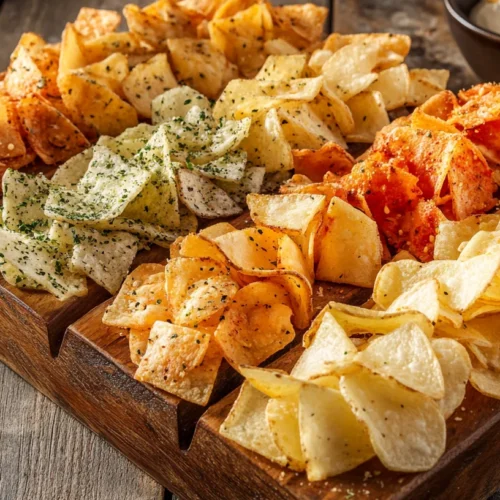
Crispy French Fries
Equipment
- Deep Fryer
- Paper towels
Ingredients
French Fries
- 4 large russet potatoes peeled and cut into thin strips
- 4 cups vegetable oil for frying
- 1 tsp salt to taste
Instructions
- Peel and cut the potatoes into thin strips. Rinse in cold water to remove excess starch.
- Soak the potato strips in cold water for 30 minutes, then drain and pat dry.
- Heat oil in a deep fryer or heavy pot to 325°F (163°C).
- Fry the potatoes in batches for 3-4 minutes until lightly golden. Remove and drain on paper towels.
- Increase oil temperature to 375°F (190°C) and fry the potatoes again for 2-3 minutes until crispy and golden brown.
- Remove from oil, drain, and immediately season with salt.

